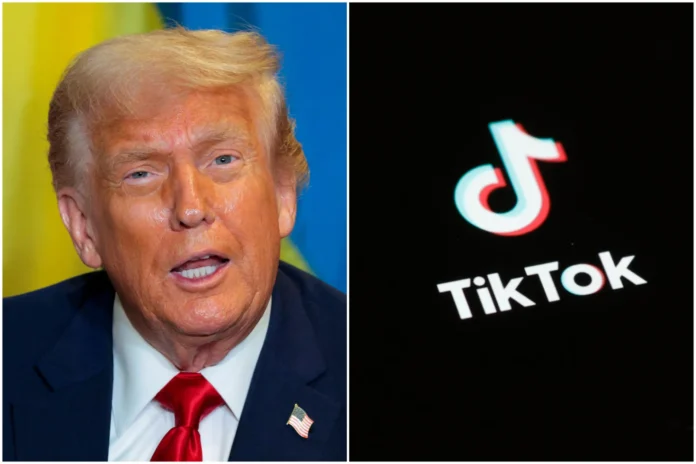Major Trade Shift and Tech Shakeup
In a dramatic move that rattled international markets, former President Donald Trump announced a sweeping set of tariffs targeting pharmaceuticals, furniture, and trucks. The announcement came alongside his approval of a $14 billion agreement transferring TikTok’s U.S. operations into American hands.
The dual measures mark a significant escalation in Trump’s trade strategy, signaling both economic protectionism and heightened national security priorities.
Tariffs to Take Effect in October
The new tariffs, scheduled to begin on October 1, will hit multiple industries. Among the most consequential is a 100% tariff on branded and patented pharmaceutical imports, unless companies are actively investing in new manufacturing plants within the United States.
Other tariff measures include:
-
25% on heavy trucks
-
50% on kitchen cabinets and bathroom vanities
-
30% on upholstered furniture
Trump argued that the measures are intended to reduce U.S. reliance on foreign products while protecting domestic manufacturing. He described the influx of imported goods as “flooding” American markets and declared the tariffs essential to national security.
Market Reactions and Industry Pushback

The announcement sparked immediate turmoil across Asian financial markets. In India, the Nifty Pharma Index fell 2.3% at market open, with major drugmakers such as Natco Pharma, Sun Pharma, and Gland Pharma losing as much as 4%. Similarly, Japan’s Topix Pharma Index slipped 1.39%, reflecting investor concerns over trade disruptions.
Industry leaders also voiced alarm. The Pharmaceutical Research and Manufacturers of America (PhRMA) cautioned that the policy could disrupt long-term investment. “Every dollar spent on tariffs is a dollar that cannot be invested in American manufacturing or the development of future treatments and cures,” the association warned.
Experts highlighted that more than half—53% of the $85.6 billion worth of pharmaceutical ingredients used in U.S. medicines—are already produced domestically, raising questions about whether tariffs will provide meaningful benefits.
TikTok’s American Future
While tariffs dominated trade headlines, Trump also finalized a high-profile executive order approving TikTok’s U.S. restructuring. The deal, valued at $14 billion, ensures the popular video-sharing platform will remain accessible to its 170 million American users.
Under the agreement:
-
Oracle, Silver Lake, and Abu Dhabi’s MGX will collectively hold about 45% ownership.
-
ByteDance, TikTok’s Chinese parent company, will retain less than 20% ownership, aligning with U.S. legislation requiring divestiture.
-
Oracle will oversee data security, algorithms, and content moderation for American users.
“This will be operated entirely by Americans,” Trump stated during the signing ceremony, noting that Chinese President Xi Jinping had given approval for the arrangement.
Prominent investors backing the deal include Oracle co-founder Larry Ellison, media executive Rupert Murdoch, and technology magnate Michael Dell.
Strategic and Political Implications
The combination of tariffs and the TikTok deal underscores Trump’s use of trade policy as a dual tool—protecting U.S. industries while advancing national security objectives.
-
Tariffs as leverage: Trump framed the furniture and cabinet duties as a direct response to oversupply from foreign markets, portraying the tariffs as necessary to protect American workers.
-
Tech and security concerns: The TikTok restructuring resolves years of uncertainty about Chinese influence over U.S. digital platforms. The deal also addresses bipartisan concerns about user data security and foreign interference.
Negotiators have until mid-January to finalize technical details of the agreement. Oracle is expected to manage U.S. data systems, ensuring compliance with American security standards.
Balancing Growth and Protectionism
Trump’s aggressive tariff strategy is likely to fuel debate over whether protectionist measures will strengthen or weaken U.S. competitiveness. Supporters argue the tariffs will pressure companies to build more factories at home, creating jobs and reducing reliance on imports. Critics warn that higher prices on pharmaceuticals, furniture, and trucks could hurt consumers while straining international trade relations.
At the same time, the TikTok deal may serve as a blueprint for handling other foreign-owned tech platforms operating in the U.S., balancing market access with national security safeguards.
Conclusion
Trump’s back-to-back announcements highlight a bold, controversial approach to both trade and technology. With new tariffs threatening to disrupt global supply chains and TikTok’s U.S. future secured under majority American ownership, the developments mark a turning point in U.S. economic and digital policy.
As markets adjust and negotiations continue, the lasting impact of these decisions will be closely watched by industries, investors, and consumers worldwide.


